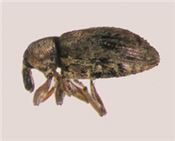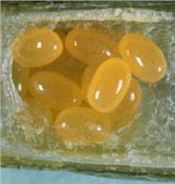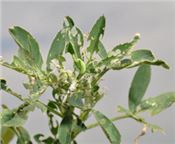Alfalfa Weevils Return To Fields After A Summer Rest
DR. LEE TOWNSEND
LEXINGTON, KY.
Newly emerged alfalfa weevils (Figure 1) usually leave fields between late May and early June. These small brown snout beetles find hiding places under surface debris or loose tree bark and enter an inactive state that lasts through the hot summer months. They return to alfalfa in fall to feed on alfalfa leaves, mate, and lay batches of up to 25 eggs (Figure 2) in living and dead alfalfa stems. Eggs hatch in spring to start the single generation that this insect has each year. Winter weather affects timing and damage potential for this key pest.
Environmental Conditions Affecting Development
Alfalfa weevil is a cool season insect that is active when the temperature exceeds a base level of 48oF. If daily high temperatures drop below 48oF early in November and seldom exceed that level through February, then most eggs will be laid in spring. A long fall and mild winter with temperatures often above 48oF allows many eggs to be laid during fall and winter. These eggs hatch earlier than spring-laid eggs, so alfalfa comes under attack before growth has gotten started. Consequently, there is greater potential for quality and yield loss (Figure 3).
Management Options
A management technique to help reduce the early spring weevil population is to remove the freeze down cutting after the crop has been frosted. This can be done by cutting or grazing, which effectively removes the places where weevils can lay eggs.
Grazing alfalfa after a sufficient waiting period provides excellent feed and removes stems where weevils lay eggs, as well as the eggs already in them. Do not graze stands where the soil is wet; large animals tramping wet soil can damage plant crowns. ∆
DR. LEE TOWNSEND: Extension Entomologist, University of Kentucky

Figure 1. Alfalfa weevil adult
Photo: Lee Townsend, UK

Figure 2. Alfalfa weevil eggs
Photo: Purdue University

Figure 3. Tip feeding by alfalfa weevil larvae appears earlier following a mild
winter
Photo: Lee Townsend, UK